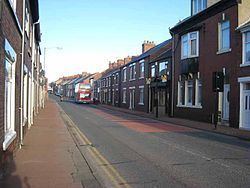Population 14,402 Civil parish Hetton Local time Friday 8:12 PM Dialling code 0191 | OS grid reference NZ354474 | |
 | ||
Weather 9°C, Wind S at 11 km/h, 93% Humidity | ||
A glorious tour of hetton le hole
Hetton-le-Hole is a town and civil parish situated in the City of Sunderland in Tyne and Wear, England. Historically in County Durham, it is on the A182 between Houghton-le-Spring and Easington Lane. It is located on the southwest corner of Sunderland on the A182, off A690 close to the A1(M). It has a population of 14,402 with the inclusion of the village of Easington Lane and Warden Law.
Contents
Map of Hetton-le-Hole, UK
The civil parish includes Hetton proper, along with East Rainton, Middle Rainton (but not West Rainton which is a separate parish), Low Moorsley, High Moorsley and Easington Lane. South Hetton constitutes a separate parish.
Great Eppleton Wind Farm, a wind farm of four dual bladed alternators, helped provide electricity to the National Grid. The original wind turbines have been replaced by larger three bladed versions. The turbines are far enough away from local houses to not cause any audible disturbance.
History
The history of the Hetton area can be traced back for up to a thousand years. The name of Hetton-le-Hole derives from two Anglo-Saxon words which were spelt together "Heppedune" or Bramble Hill. The name gave rise to a local landowning family, the le Hepdons who owned part of the Manor from the very earliest times. The ancient manor, which was bounded by that of Elemore, was divided into two parts known as Hetton-on-the-Hill and Hetton-in-the-Hole. This second and more sheltered part, was the vicinity in which the village ultimately arose. Records exist of the many holders of the manor right back to the 14th century. William de Hepdon held half the Manor by deed in 1363 and in 1380, William de Dalden held the other half. Even earlier charters go back to 1187 and make mention of the early village of Heppedune, its people, houses, crofts, ox-gangs and strips of land for the villagers in the three great fields around the settlement. In 1187 Bertram de Heppedune held the manor for the King and the other de Hepdons were his descendants.
Coal mining has been carried on in the surround area since Roman times. Coal was then obtained by drift mining, but by the 14th century shafts were used. In 1819 the Hetton Coal Company was formed and the first shaft sinking began a year later. It was a highly controversial undertaking, with geologists doubtful as to whether coal of any value existed there. The Hetton Coal Company owners also decided to build a wagonway from their new Hetton colliery to the River Wear at Sunderland. George Stephenson was hired to build the 8 miles (13 km) line. The finished line used a gravity down its inclines and locomotives for its level and upward stretches, and was the first railway to use no animal power at all. The methods he adopted were still used until 1959 as was some of the original machinery. These activities led to a rapid increase in the size of Hetton and over 200 houses for the miners were built at once. These have all but gone now, but twelve of these former mining cottages from Francis Street in the Hetton Downs area of the town were re-erected stone by stone at Beamish Open Air Museum, Stanley, near Chester-le-Street. The UK miners' strike (1984–1985) brought about hardship for many of the workers. Two local unsigned bands (The Pigeon Fanciers & Haswell Crisis) recorded and released a single to both raise money for the families and to recognise the contribution made by miners over the years in their locality. Their adapted version of a Bob Dylan classic failed to chart, but the project made a slight profit as local support from other mining communities ensured that 'Knocking on Hetton's Floor' sold in excess of 1000 copies.
Today, nothing now exists of the mine in Hetton. The former mine complex has disappeared and spoil tips have been removed, although some remain in nearby Haswell. The surrounding area has been landscaped and is now occupied by a lake and leisure facilities. There is also a quarry where sand is mined. This is now undergoing a reformation; around 15% of it has been smoothed and grassed over.
The decommissioned St Nicholas' Church on Front Street was destroyed in November 2006. It is unknown if arson was the cause of the fire. It had previously been listed due to its architectural significance.
